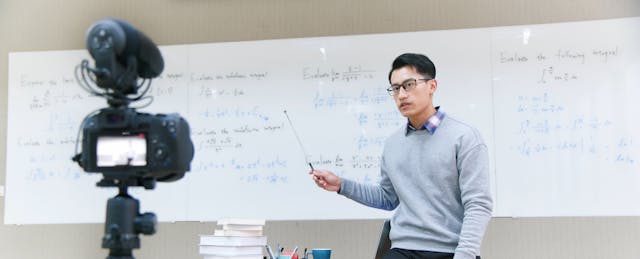On March 12 and 13, 2020, the University of Michigan cancelled class to prepare the whole campus for emergency remote teaching starting on March 16. In that brief interim, the institution made Zoom available to everyone—possibly the fastest rollout of any tech in the university’s history, says Ravi Pendse, vice president for information technology and chief information officer.
The video platform allowed professors to host live classes virtually, complete with real-time speech-to-text transcriptions. It also enabled them to record lectures or class discussions for students to watch and rewatch anytime. That option proved useful for students with unreliable internet access at home, those living in far-away timezones, and those who had trouble following along with professors who were teaching while wearing masks.
“For all those reasons, recording those lectures and making them available was the right thing to do, and a significant number of faculty colleagues decided to do that,” Pendse says.
Whether their courses have been hybrid, HyFlex (taught in a way that lets each student pick between in-person or online), fully online, or (theoretically) fully in person, many more professors have found themselves recording their lectures over the last two years. And even though by now many institutions have moved beyond their early improvised solutions to pandemic challenges, taping lectures has stuck around.
It’s a change that some students like. But some instructors aren’t so sure about it—and what it might mean for their teaching strategies, for their privacy or that of their students or for their intellectual property.
We’re publishing a series about how pandemic-era practices are continuing to shape higher education. Check out related article, “Colleges Are Providing Tech to Students to Shrink the Digital Divide.”
The practice has precedent among proponents of “flipped learning,” a model that assigns students to watch lectures as homework and reserves class time for interactive activities. Pendse sometimes taught that way before the pandemic when he felt it made the most sense for a particular course. It also has supporters among advocates for students with disabilities, who say recorded lectures enable people who have hearing loss, processing difficulties or other challenges to pause and replay material, or read transcripts, to better understand it and take notes.
“Lectures that are recorded can benefit all students. It makes a course inclusive, supportive and accessible,” says Jennifer Albat, an instructional designer at Southern Illinois University at Edwardsville. “It brings equity to the course. Everyone is on the same playing field.”
Recorded lectures can also help students who miss class because of work or caregiving responsibilities, commuting trouble or, these days, quarantine requirements due to exposure to COVID-19.
“There are any number of reasons a student would have to miss class,” Albat says. “My provost likes to call it ‘showing grace to students.’”
Yet some professors are worried about what recording their lectures might mean for their teaching practices and course expectations. One fear is that it could make it too tempting for students to skip class for less-pressing reasons. That’s a phenomenon that predates the pandemic at medical schools, where many students routinely stay home and watch recordings—sometimes at double the normal speed. Studies about the effects of recorded lectures on student attendance have yielded mixed results.
Also, teaching to a camera instead of a room full of students does not feel the same to many instructors.
“I do miss those physical, verbal cues that you get when you’re in person in a room with people,” Pendse says. “It’s really, really hard to catch that in a Zoom environment, and the video fatigue people go through.”
Another point of contention: In an era of heightened tension about academic freedom and “controversial” courses, some instructors are loath to make it easier for their material to escape the classroom and possibly be used against them. That’s not just a hypothetical situation. Florida recently passed a law empowering students to use recorded lectures to issue complaints about professors’ “political bias.”
“Students ripping the videos down and putting them out of context on social media is always a concern,” Albat says.
Privacy for students is another worry. If a classroom is being recorded, students need to know, according to Pendse. The University of Michigan has published guidance about getting student consent for recordings and related best practices, which other institutions have requested to use for their own campuses.
And it’s not always clear who owns and controls recorded lectures that are hosted and shared through university or third-party edtech systems. Colleges can create policies that give them copyright over material that professors record, which has prompted some professors to conceive of scenarios in which they lose their jobs but institutions keep using their recordings. (Did you hear the one about the dead professor teaching?)
The American Association of University Professors has issued guidance on remote teaching and copyright, as well as a warning that “institutions should not take this opportunity to appropriate intellectual property to which they would not otherwise have had access; teaching materials moved online because of the one-time emergency created by COVID-19 are not the property of the institution for future use.” Experts say faculty should double-check their institutions’ policies and watch for any changes.
The University of Michigan has experience navigating intellectual property rights questions thanks in part to its prolific partnership with open-course provider Coursera, Pendse says. He explains that, in general, professors at the university retain ownership of their content and can take it with them if they leave, unless they were specifically hired to produce material exclusive to the institution.
Despite the possible drawbacks, both Albat and Pendse foresee recordings becoming more common, although not required, among professors. Pendse says students have even come to expect it.
“I feel that the world is moving more and more toward blended learning,” he adds. “I do believe the recording of lectures and uploading of lectures is here to stay.”


